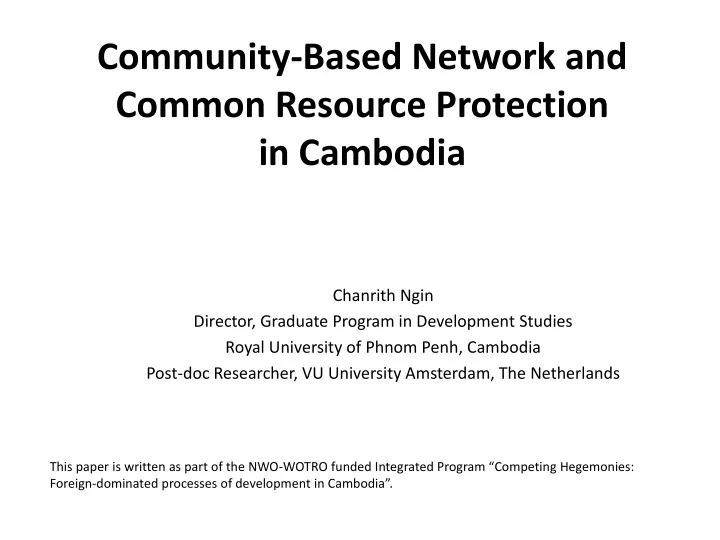

Community-Based Network and Common Resource Protection in Cambodia Chanrith Ngin Director, Graduate Program in Development Studies Royal University of Phnom Penh, Cambodia Post-doc Researcher, VU University Amsterdam, The Netherlands This paper is written as part of the NWO- WOTRO funded Integrated Program “Competing Hegemonies: Foreign- dominated processes of development in Cambodia”.
Presentation Outline 1. What we wanted to examine 2. How we examined 3. What we found and how it implicates policy and practice 4. Conclusion
1. What we wanted to examine • To examine a theoretical underpinning that networked CBOs render an effectual collective bargaining power to defend their common interest • To examine the functioning of such a network and conditions which bolster and hinder the network
2. How we examined • Analysis of secondary material (studies, NGOs’ and Donors’ reports, media articles, websites, etc) • Analysis of interviews with Committee Members of the Network and representatives of NGOs and donor agencies
3. What we found 3.1 Synopsis of Prey Lang Network (PLN) 3.2 Functioning of PLN 3.3 Conditions impeding PLN
3.1 Synopsis of Prey Lang Network (PLN) Source: http://friendforest.wordpress.com/prey-lang-map/
Source: http://www.culturalsurvival.org/take-action/cambodia-help-us-save-prey- lang-our-forest/cambodia-photos-videos-and-maps
• Spanning Preah Vihear, Kampong Thom, Kratie and Stung Treng provinces • Largest area of first-growth lowland rainforests remaining in Southeast Asia, covering 750,000 hectares • Around 200,000 people, mostly indigenous Kuy, reside in 339 villages in six districts surrounding the forest; and about 350,000 people live in the greater Prey Lang area. • The Kuy are customary forest guardians, have intimate social and spiritual traditions with the forest, and rely their livelihoods on the forest through food and medicine gathering, resin tapping, and collecting building materials.
• The government has granted over 40,000 hectares of the forest as economic land concessions (ELCs) for rubber plantations and 27 exploration licenses and related concessions to mining firms. • Some of the concessionaires are run by Cambodian conglomerates related with politicians and the army. • In 2007, communities around the forest in the four provinces formed the Prey Lang Network. • These committee members were selected by around 100 Network members at a meeting in Phnom Penh. • The founding of the Network was assisted by various LNGOs and INGOs through coordination of meetings among the Network members.
• Many communities of the network have agreed their own forest use rules and cooperated on forest patrols to discourage illegal activities. • The Network has been technically and financially aided by different LNGOs, INGOs and donors. • It has also liaised with other CBOs and networks. • In January 2012, the government drafted a sub- decree to preserve over 600,000 hectares of the forest as a protected zone. The Network members demanded consultation with them before the sub-decree is issued.
3.2 Functioning of PLN
Density of relations • By nature and location, it is a loose network of about 200,000 villagers living around the forest that spans 339 villages in six districts of the four provinces. • Organizationally, the Network is managed by four committees (one committee in each province) comprising twenty members as representatives of the general members. • Informal status • No statute or membership criteria
Degree of cohesiveness • Network composition is homogenous and cohesive by nature. • Existence of committees (subgroups) for a geographical reason • No evidence of “us -and- them” attitudes among the committees • Two committees were less active and difficult to reach due to the remoteness of their localities. • Committee members coordinate and mobilize general members for activities such as meetings, patrols and protests. • Committee members expressed a staunch will and motivation in their coordination work. • Only around 300 members at most participated in protests and about 15 members from each village at most partook in patrols which were held in turn twice a month.
Subgroup interconnectivity • Committees (subgroups) were created for a geographical reason and coordination purpose. • No indication of specialization among the committees (subgroups). • Chairman (representative) of the Network communicates with other committee members in other provinces for coordination.
Degree of network centralization • Functioning is primarily shouldered by the committee members who plan and coordinate activities with supporting bodies. • Chairman (representative) and two committees took the lead in organizing activities. • Dependency on the committee members (and the informal status) posed questions of legitimacy and representation (esp. by local authorities). • Information diffusion among the committee members and between the committee and general members was at times slow.
3.3 Conditions impeding PLN • Limited planning and strategic capacity • Plans based on supporting organizations’ projects/programs • Polarized external support: capacity-oriented vs. activity-oriented • Lack of strategic engagement with other community-based networks • Disfavor and menace by national and sub- national authorities
3.4 Implications to policy Policy to support community-based networks should consider: • Both practical and institutional capacity-building of the organization • Financial and technical capacities and burdens of active committee members and the organization • Dependency of general members on active members • Strategic and long-term alliances with other networks and stakeholders • Economic and political power relations between the network and other stakeholders, esp. private interests and government authorities
3.5. Implications to practice • Support should focus on reality: fear of communities; preference for being informal and collective; focus on both activity and capacity, and economic and political empowerment • Support should not be fragmented and directed to diverging agendas • Support should address power relations and should not avoid political economy • Research should be integrated into policy and practice of support
4. Conclusion PLN faced two major hurdles: • Structural constraints: density of relations, cohesiveness, network centralization • Environmental constraints: external dependency, fragmented support, political pressure Policy and practice of support do not sufficiently tap empirical studies.
Thank You!
Recommend
More recommend